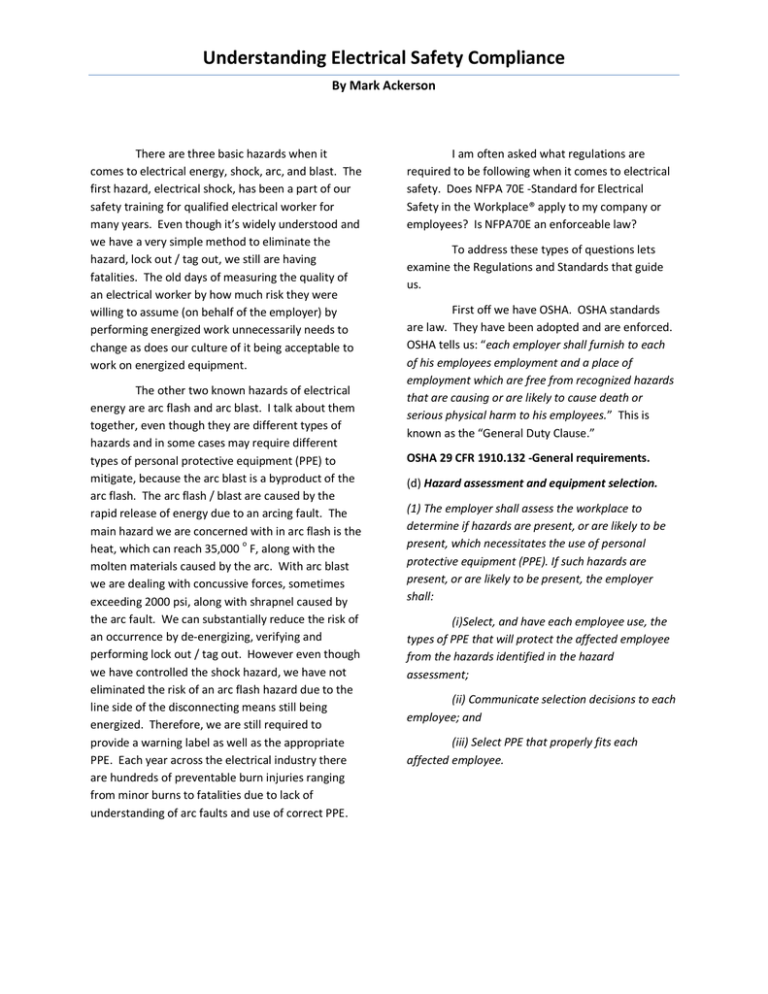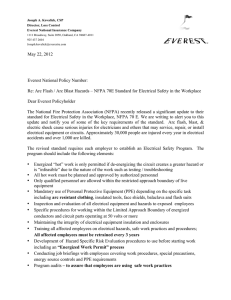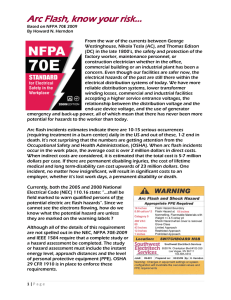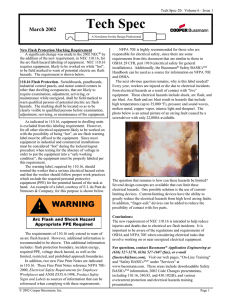Understanding Electrical Safety Compliance
advertisement

Understanding Electrical Safety Compliance By Mark Ackerson There are three basic hazards when it comes to electrical energy, shock, arc, and blast. The first hazard, electrical shock, has been a part of our safety training for qualified electrical worker for many years. Even though it’s widely understood and we have a very simple method to eliminate the hazard, lock out / tag out, we still are having fatalities. The old days of measuring the quality of an electrical worker by how much risk they were willing to assume (on behalf of the employer) by performing energized work unnecessarily needs to change as does our culture of it being acceptable to work on energized equipment. The other two known hazards of electrical energy are arc flash and arc blast. I talk about them together, even though they are different types of hazards and in some cases may require different types of personal protective equipment (PPE) to mitigate, because the arc blast is a byproduct of the arc flash. The arc flash / blast are caused by the rapid release of energy due to an arcing fault. The main hazard we are concerned with in arc flash is the heat, which can reach 35,000 ο F, along with the molten materials caused by the arc. With arc blast we are dealing with concussive forces, sometimes exceeding 2000 psi, along with shrapnel caused by the arc fault. We can substantially reduce the risk of an occurrence by de-energizing, verifying and performing lock out / tag out. However even though we have controlled the shock hazard, we have not eliminated the risk of an arc flash hazard due to the line side of the disconnecting means still being energized. Therefore, we are still required to provide a warning label as well as the appropriate PPE. Each year across the electrical industry there are hundreds of preventable burn injuries ranging from minor burns to fatalities due to lack of understanding of arc faults and use of correct PPE. I am often asked what regulations are required to be following when it comes to electrical safety. Does NFPA 70E -Standard for Electrical Safety in the Workplace® apply to my company or employees? Is NFPA70E an enforceable law? To address these types of questions lets examine the Regulations and Standards that guide us. First off we have OSHA. OSHA standards are law. They have been adopted and are enforced. OSHA tells us: “each employer shall furnish to each of his employees employment and a place of employment which are free from recognized hazards that are causing or are likely to cause death or serious physical harm to his employees.” This is known as the “General Duty Clause.” OSHA 29 CFR 1910.132 -General requirements. (d) Hazard assessment and equipment selection. (1) The employer shall assess the workplace to determine if hazards are present, or are likely to be present, which necessitates the use of personal protective equipment (PPE). If such hazards are present, or are likely to be present, the employer shall: (i)Select, and have each employee use, the types of PPE that will protect the affected employee from the hazards identified in the hazard assessment; (ii) Communicate selection decisions to each employee; and (iii) Select PPE that properly fits each affected employee. Understanding Electrical Safety Compliance By Mark Ackerson OSHA 29CFR 1910.335 -Safeguards for personnel protection (a) Use of protective equipment (1) Personal protective equipment. (i) Employees working in areas where there are potential electrical hazards shall be provided with, and shall use, electrical protective equipment that is appropriate for the specific parts of the body to be protected and for the work to be performed. (v) Employees shall wear protective equipment for the eyes or face wherever there is danger of injury to the eyes or face from electrical arcs or flashes or from flying objects resulting from electrical explosion. (2)General protective equipment and tools (ii)Protective shields, protective barriers, or protective insulating materials shall be used to protect each employee from shock, burns, or other electrical related injuries while that employee is working near exposed energized parts which might be accidentally contacted or were dangerous electrical heating or arching might occur. When normally enclosed live parts are exposed for maintenance or repair, they shall be guarded to protect unqualified persons from contact with the live parts. As outline above, OSHA does require us to do some things to protect workers from electrical hazards. A risk assessment must first be done, then, based on the risk assessment, appropriate PPE should be selected and provide based on the known hazards of electrical energy, shock, arc, and blast. OSHA provides little guidance as to how we assess the hazards of electrical energy, or once we know the hazards, how to select the proper PPE. That is where NFPA 70E -Standard for Electrical Safety in the Workplace® comes into play. NFPA 70E was developed and written at the request of OSHA. It is a consensus document written and approved by a cross sectional group of electrical experts from both business and industry. It provides methods for assessing the hazards of electrical energy. Typically consensus documents are not enforceable by law, however, NFPA 70E has been used by OSHA to issue citations and has been upheld by courts of law. Once we have determined the amount of incident energy, NFPA 70E also provides us with guidance in the selection of PPE to provide appropriate protection for the employee. Both the National Electrical Code (NEC) and NFPA 70E give us direction as to how to “communicate selection decisions to each employee” in the form of labeling. This label required by the NEC in article 110.16 requires all electrical equipment (other than in dwelling occupancies) that are “likely to require examination, adjustment, servicing, or maintenance while energized” to be field marked to warn qualified persons of the potential of electrical arc flash hazards. In the NEC, article 110.16, a fine print note references NFPA 70E for guidance. Shouldn’t qualified persons already have this knowledge? That’s why we hire qualified electricians right? The truth is, unless you went through you electrical training in the last 5 years chances are you never received any formal training on this newly understood phenomenon known as arc flash. Herein lies the problem, there are thousands of “qualified electrical worker” who have never received proper training to deal with this hazard. The bottom line is this; there is no one place or document that can be quoted to say this is “the letter of the law“ when it comes to arc flash compliance. It takes a combination of documents to provide a safe work environment. I will leave you with this thought. Safety programs designed to only meet “the letter of the law” tend to be reactive, your ultimate reason for a proactive safety program should be because it’s the right thing to do. Mark Ackerson is the owner of Ackerson Electrical Contracting Inc. specializing in electrical safety solutions including training, consulting and safety program development. He may be contacted at MAckerson@cablespeed.com © 2010 Mark Ackerson




